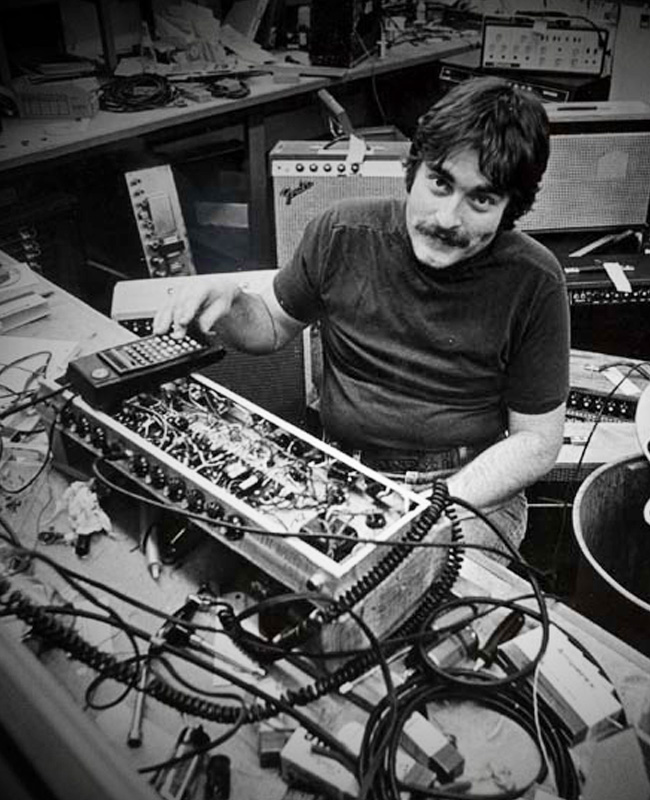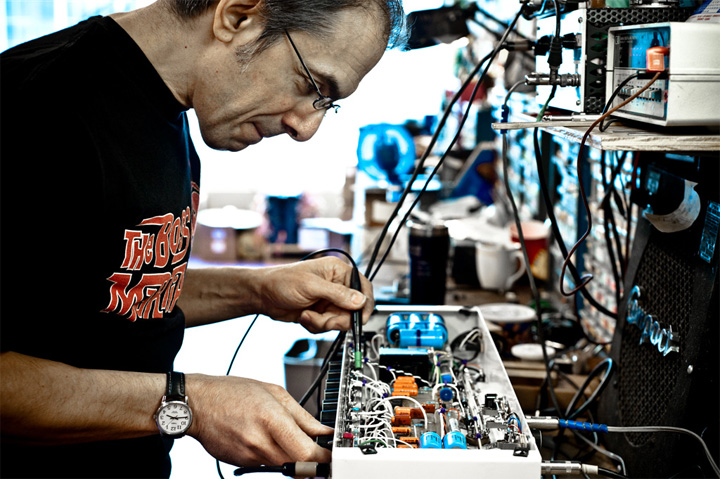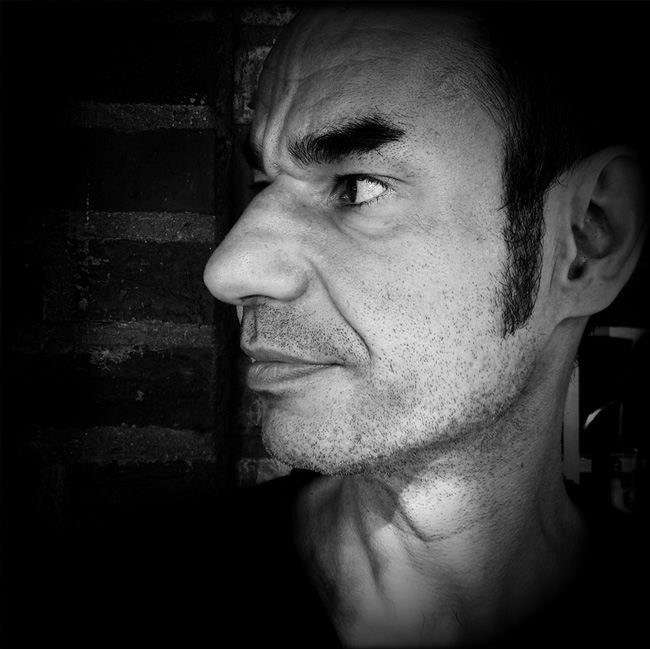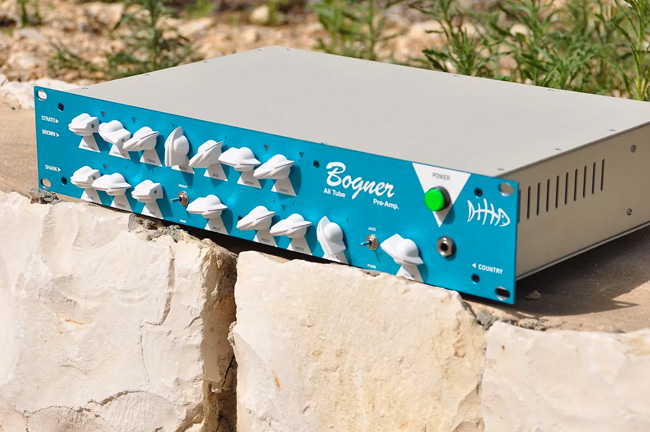It’s easy to take for granted how common high–gain amps are these days. When you walk into your local music store or browse the internet in need of a high–gain amp or one with multiple channels, you’ll find dozens of options.
But any guitar player who has been around long enough can surely remember when it was tough to get a great distorted sound out of an amp without cranking it to oblivion. Amps with multiple channels didn’t exist a few decades ago either, and you were more or less constrained to the tones offered by the big amp brands.
One group of young amp techs working in the late ‘70s and early ‘80s is just about solely responsible for the revolution in the amp market that made it what it is today. And the curious piece of history that unites Reinhold Bogner, Paul Rivera, and Michael Soldano is their origin as amp modifiers.
After all, there are no college courses on how to build a great amp. Bogner, Rivera, and Soldano all learned their skills through trial and error, input from musicians, and gut instinct.
Once these amp gurus became overloaded with work, most of them took things to the next level by starting their own companies. Through those amp companies, their mods became the standard features that so many modern players love in high–gain amps today.
Soldano would help invent cascading gain structures that would help players get great distorted tones at any volume. When extreme metal bands started getting really heavy, Bogner and Rivera created their own ultra–brutal amps, the Knucklehad and the Uberschall, that could handle ultra–low tunings without getting muddy.
Many guitar players first became aware of amp mods from Eddie Van Halen. Everything Eddie touched turned to gold at the time, and when he mentioned in an interview that his Marshalls were modified by the Jose Arredondo, Arredondo’s business exploded. That helped break modding into the mainstream, and gave Arredondo’s contemporaries a bottom line to launch their businesses from.
The Early Rivera Story
As Paul Rivera told me, there weren’t amp mod guys in the late '60s, but there was, of course, amp repair. Rivera started modifying amplifiers as early as 1968 out of his first shop in New York.

Paul Rivera, 1979
Rivera is one of the only amp wizards with electronics schooling, but as he explains, "The only thing you learn in school is fundamentals. You can learn various formulas, but that doesn’t tell you how to make something sound good. That’s something that’s done from your own research, along with trial and error."
Rivera also learned a lot when he worked as an apprentice in a New York recording studio. "Working on recording consoles teaches you a tremendous amount about audio," he continues. "That kind of background helped a lot in training my ears."
In 1975, Rivera settled in Hollywood, and word of mouth made his business snowball from there. "I was doing mods for studio cats like Jay Graydon and Dean Parks in L.A., but I also heard from a lot of session cats in New York and Nashville. Chet Atkins had heard about me from Larry Carlton, and once I did a mod for Chet, the Nashville cats called. I was very fortunate in the early days to be in places where we had great musicians, and I had their ears."
A lot of the amp wizards were unaware of their colleagues back in the ‘70s. Up in the Bay Area, Randall Smith started modifying amps in 1971, launching what would arguably become the first successful amp company started by a modifier: Mesa/Boogie.
The only thing you learn in school is fundamentals. You can learn various formulas, but that doesn’t tell you how to make something sound good." - Paul Rivera
By 1980, Rivera was hired by Fender to help bring the company back to life. "I brought my mods into Fender, and spun them into a lot of the amplifiers they made during my tenure there. The problem was, how do you work for a company, get to be creative, get to design products, and enjoy yourself in that creative sense? It’s very hard to find an outlet for that in a corporate environment."
While working at Fender, Rivera learned a lot about marketing, manufacturing and distribution, and by 1984, when he was in his early 30s, the time was right to leave and start his own company. "I thought, If I don’t do it now, I probably won’t, so… Let me do it!"
Soldano Makes the SLO
What drew Michael Soldano to amp modding was a simple imperative. "The whole beauty of American ingenuity is that if something’s not doing what you want it to do the way it is, you can figure out a way to do it better, or do it differently," he says. "So I applied that same ethic to guitar amps, and it worked."
At first, Soldano built his own guitars because "at the time, I couldn’t find a guitar that sounded and played the way I wanted it to, and I just couldn’t buy an amp that had the sound I wanted either. Back then, I still had the big dream of being a rock star, and I was trying to get this killer guitar sound that nobody else had."

Michael Soldano
Soldano had taken some physics courses in high school, but when he tried to further his electronics education at a local community college, the teacher told him, "Nobody’s doing tubes anymore. We’re doing solid–state stuff now. If you took this course, we’d probably touch on tubes for five minutes and that’s it."
"Being the Mr. Do–It–Yourself I’ve always been, I thought I’d just go to the library," Soldano continues. At the library, he dove into old tube reference books and Navy electronics manuals. "It’s pretty dry reading, but I learned about engineering and how vacuum tubes worked." Soldano then bought an oscilloscope at a pawn shop and worked on friend’s amps at night while working at an auto body shop during the day.
The whole beauty of American ingenuity is that if something’s not doing what you want it to do the way it is, you can figure out a way to do it better, or do it differently." - Michael Soldano
Marshalls weren’t easy to come by when Soldano was growing up in Seattle. "If a guy had a Marshall, he was the cool guy on the block because they were expensive," he says. "Seattle was a blue collar town back then, and most of the guys that played around here didn’t have a ton of money, so they had old Fender Bassmans, or Fender Twins."
As it turns out, this was a blessing in disguise for Soldano when he was experimenting and developing his amp designs. "50–watt Bassmen were dirt cheap back then, and it was the easiest amp to mod. You could tear into one of those and not feel bad about it."
Soldano eventually found the key to getting a great high–gain tone at low volumes. "What everybody was doing prior to me was taking one tube and hitting it really hard. You got a lot of gain out of that one tube, and then you used it to overdrive the entire amp."
With Soldano’s amps, however, "There’s a lot of tubes that are doing the gain, but no one tube that’s doing that much gain. It’s like you’re driving a car with a six speed. You’re slowly and gently ramping up all the gain through a lot of stages, whereas other amps were doing it from first gear to high gear. They’d get all their gain in one, big jerky lurch, where I was kind of finessing it.
"My whole deal from day one was I wanted to get it all in the preamp, because I wanted to be able to have my sound just as good at any volume."
Soldano was "a total headbanger at the time," and called his standard amp modification the "Metal Master." Soldano then took what he learned from modding other people’s amps into his own model, the Super Lead Overdrive, or the SLO. Although he was going for a metal vibe, the SLO "turned out to be a much more versatile amp because there were other guitarists playing through it that were better than I was, and they could expand on its usefulness."
After leaving Seattle for Los Angeles, Soldano opened his own shop in Hollywood on April Fool’s Day, 1987. Two years later, Reinhold Bogner would make a similar journey to Los Angeles himself.
Bogner Sets Up Shop in California
Bogner grew up surrounded by electronics in his native Germany because his father was an engineer who loved to collect old tube radios. Unable to afford his own amp, Bogner says, "I tried to make an amp from parts my father had laying around." Bogner also had to get great tones at low volumes, because whenever he played too loud, his irate father would go the fuse box and shut off the electricity in his room.

Reinhold Bogner
Eventually, Reinhold was happy with the tones he was getting and started to modify amps for local musicians. Bogner then modified an amp for Kansas guitarist Rich Williams, who told Reinhold he should go to L.A. It was a leap Bogner was eager to take because he realized he could only go so far in his native Germany.
Bogner arrived in L.A. in 1989 with one of his hot–rodded Marshalls and $600 in his pocket. He knew about Andy Brauer, who rented boutique gear to practically every great musician you could think of, so Bogner took the bus to Brauer’s shop, hoping for a job. Once Bogner plugged into his Marshall, Brauer liked what he heard, and Reinhold started work that Monday.
Once Soldano and Bogner set up shop in L.A., they didn’t have to wait long for players to beat down their doors. The SLO attracted a wide variety of great players, including Eric Clapton, Warren Haynes, Eric Johnson, Warren DeMartini, Steve Lukather, and Eddie Van Halen, among many others.
At Andy Brauer’s shop, Bogner first mods were for Steve Stevens, studio legend Michael Landau, and Dave Jerden, who was producing the debut album from Alice in Chains, Facelift. Once the world was blown away by the brutal tone Jerry Cantrell got from Bogner’s modified Marshall, the floodgates opened.
Bogner then made two rackmount preamps, the Triple Giant, followed by the Fish. It was the era of the preamp, where a lot of guitarists had refrigerators full of rack mount gear, and as Bogner recalls, "A preamp was easier to do because I didn’t have the resources at the time to do a whole amp."

Bogner Ecstasy 101B

Bogner Fish Reissue
After a year of research and development, Reinhold finally created the Ecstasy, his first full–blown amp, which hit the market in 1992. With the Ecstasy, Reinhold created a three–channel amp with a lot of options so that every player could customize their own amp with a lot of sonic options.
"It’s really hard to make a two– or three–channel amp where each channel sounds good in the same package," Bogner says. "I think I was able to put those two things together — not just the high–gain tones, but also the flexibility."
Bogner and Rivera also had great success when bands tuned down lower than ever and needed ultra–heavy amps to get the job done. Bogner came up with the Uberschall (which is "supersonic" in German), and Rivera came up with the Knucklehead model, as well as the Powered Sub cabinets that can handle the extreme bottom end.
To me, the biggest error an amp guy can make is thinking he knows it all in terms of what something’s supposed to sound like." - Paul Rivera
Once bands like Korn and Slipknot came to Rivera, he was excited to work with something new. "You talk to these cats, ‘What do you want?’ Then you realize, ‘Oh my God, these guys are playing in drop A! How are we gonna do it? How are we gonna get speaker cabinets to do this?’ Then you start racking your brain and create something. That’s the fun part, and I just hope it keeps going and people keep coming up with new things.
"To me, the biggest error an amp guy can make is thinking he knows it all in terms of what something’s supposed to sound like," Rivera adds. "You box yourself into a particular tone, and it keeps you from learning and growing, and creating new products for players."
Except for Lee Jackson, who modified amps for Paul Gilbert, George Lynch, Steve Vai, Zakk Wylde, and Caesar Diaz (who gained fame as Stevie Ray Vaughan’s tone doctor), the amp wizards usually didn’t advertise, preferring to let their businesses grow by word of mouth.
This was certainly the case with the late Jose Arredondo, who oddly enough is both one of the most well–known and yet mysterious tone gurus in history. He didn’t save his secrets for future generations, and trying to track down any biographical information on him was not easy.
The Lifer, Arredondo
Arredondo got his start working for Vox — he reportedly had a hand in their Super Beatle amps — and Ampeg, which is where Paul Rivera believes they met. But it was the work he’d do on Eddie Van Halen’s amps that would make Arredondo legendary. In fact, once EVH started dropping Jose’s name, Arredondo was modifying Marshalls like crazy.
In recent years, Van Halen maintains that Arredondo didn’t really mod his amps, claiming he just mentioned Jose’s name to help out his business. But before Arrondondo’s death, they were indeed working on an amp together that would have been available in stores. When that didn’t pan out, Ed went with Peavey and created the 5150 instead.
Supporting the widely held belief that Arredondo routinely worked on Eddie’s amps are the several sources who have told me that Arredondo was not allowed to modify anyone else’s amp that same way he hot–rodded Ed’s.
Opinions on Arrendondo’s amp mods are mixed, but he did indeed have many satisfied customers, including Steve Vai, John Sykes, and James Hetfield, whose modified Marshall provided the killer riff tone of Kill ‘Em All. In fact, when that Marshall was stolen on the road, Hetfield wrote "Fade to Black" because he was crushed that his favorite amp got ripped off.
Metallica - "Seek & Destroy"
Bryan Jay, who played guitar in the ‘80’s metal band Keel, had a Marshall modified by Jose, and he recalled that Arrendondo wasn’t the easiest guy in the world to track down. "You had to know somebody that knew somebody that knew him to reach him," Jay recalls. "Thinking back, my mod was kind of difficult to get."
Jose had a shop, Arrco Electronics, but Jay recalls going to Arredondo’s home (both were located the San Fernando Valley). In Arredondo’s garage, Jay saw several Marshalls sitting around with name tags on them: George Lynch, Yngwie Malmsteen, Jake E. Lee. Although Arredondo was a friendly and talkative guy, he never talked about what he was doing with anyone else’s amps. "He was very secretive," says Jay.
We’d put up different amps in our rehearsal studio, and the Jose always blew everything away. It was unbelievable how good it sounded." - Bryan Jay
Although Jose was much older than the musicians he worked for, "He was young at heart," Jay recalls. "Definitely had some fire in him." Arredondo was from Argentina, and he spoke with a heavy accent that was hard to understand at times. But when it came to tone, there were no communication problems at all. "What I basically wanted was that kind of first Van Halen album sound, and he seemed to know exactly what I wanted," Jay says.
When Jay picked his amp up several weeks later, he was very pleased with the results. "We’d put up different amps in our rehearsal studio, and the Jose always blew everything away. It was unbelievable how good it sounded."
Jose gave the amp an extra preamp tube, as well as a special pull knob. "When you pulled the knob out, it dropped the volume, but you still had all this gain," Jay continues. "It sounded like it was on ten."
Arredondo didn’t live long enough to have his own model amp on the market, but ironically, an amp based on Jay’s modified Marshall was released to the public, the Peavey VTM.
"The Vice President of Peavey was best buddies with one of our managers," says Jay. "They wanted us to use their equipment because they were real big on the country [music] side, but they were really trying to break into the rock world.
"They asked if they could borrow the Jose amp, and if they could design an amp that sounded as good or better, would we use it? We said okay. They took it apart, saw what he did, and modeled the VTM after it. They didn’t know the amp was based on a Jose modified Marshall."
As for the Marshalls that Jose modified over the years, they remain as elusive as the man himself. Anyone who still owns one has a rare, and valuable, commodity. "I know you could get a good penny for it," says Jay. "I remember somebody offering me like $15,000 for the thing. Now I feel like I should have sold it for that, but I never would have seen it again."
Jay eventually did end up selling his Jose Marshall to a friend, so he knows where to track it down if he ever gets the urge to play through it again. "And I know he won’t sell it."



